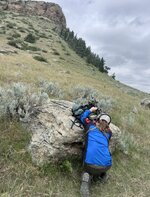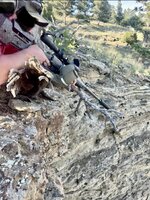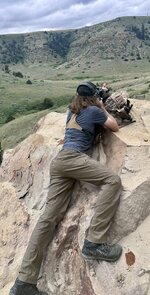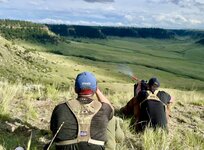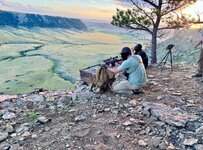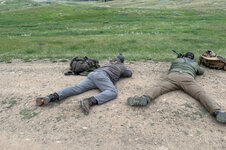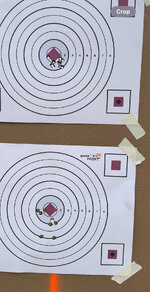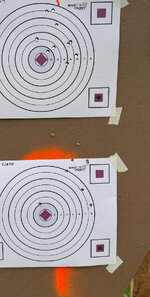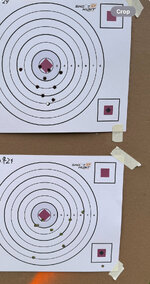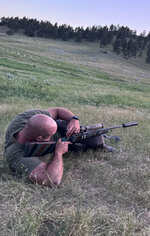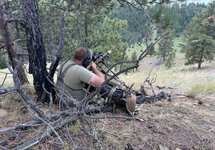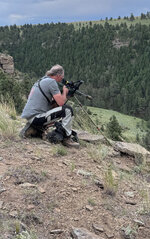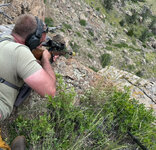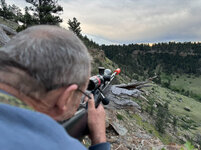The second class.
Conditions:
First day was nice with medium wind. Second and third day were a rainy, sandy mess. Rest of the class was nice with very little wind.
Beginning of day 2. It got much wetter/sloppier-
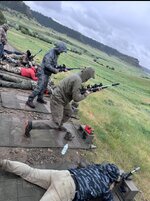 Participants:
Participants:
12 participants that ranged from competent with a relatively high level of base skill, to nearly no skill whatsoever. Most people were above average in shooting by almost any external measure. Each shooter fired +/- 700 rounds of ammunition in 5 days.
The average body position of shooters when prone on day 1 was much closer to ideal than class one, but not all the way.
This was the “most zeroed” rifle on day one with no time limit on top, and timed shots on bottom (two separate drills)-
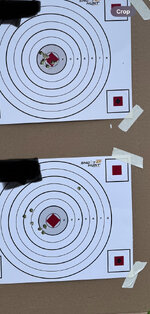
I don’t have pictures of the worst, but most were not on paper- 8-9 inch groups (some equipment issues).
Most were solidly in the middle, like this-
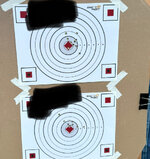
On the field shots on day one, first round hits rates from 140’ish yards on life size animal targets, to over 1,100 yards with most being in the 400-600 yard range; were 10% or less, and most hits were wounding shots not vitals. Time to first shot was long for most, very long.
Equipment:
This class had many issues with equipment.
Rifles:
Most shooters used Tikka T3’s, a couple R700 pattern actions- Bergara and Christianson .
Tikka: One tikka 223 (call it #1) was ceracoated with a RokStok and had major issues. The mags sat too deep in the rifle and made the bolt drag on it. It destroyed the feedlips of 5-6 mags very quickly. We tried about everything to get it to work, and nothing really helped. A major problem for this rifle, and a second was BlackHills ammo that had sizing lube or case lube still on it that made the round stick in the magazines- more on that later.
A second S2H rental rifle also had mags issues. This rifle ran without issues the previous class for more than 1,000 rounds. There were some stock/part swapping after the first class, and this rifle was one. Not sure if it was the damaged mags, the Blackhills ammo, a tolerance issue with the swapped stock/bottom metal, or it was just possessed. The rifle will be sorted out.
Two shooters with Tikka CTR magazine rifles had constant issues with the rain and sand getting inside the mags. The CTR mags are much less reliable than TRG and AI mags, and significantly more susceptible to failure with debris. After the rain stopped one shooter was able to clean his mags out and stretch the springs with no further issues. The other shooter swapped to a standard Tikka bottom metal and mags and his rifle functioned correctly for the entire course.
The Tikka 223 mag system presents very little of the case head to the bolt for stripping the round from the magazine- dimensional tolerances for correct feeding are vital. As well, followers were tore up/scratched heavily from the sand and gravel on day 2 and 3, and contributed to issues- smoothing the followers up on a couple of mags helped. Any of the larger cartridges the mag presents much more case head to the bolt and reliability was/is excellent.
Tikka trigger replacement springs- don’t. We had two rifles whose triggers were loose and allowed the sear to release on bolt close- this is 3 rifles in 3 classes this year. A 2.75lb to 3lb trigger (factory spring) is an excellent weight for a field gun, lower than that accounts for fully half of the ND’s we have seen in the field. Furthermore, the rifles will/can become unsafe. The Finns are not “lawyered up”- they appreciate good triggers more than we do. The factory trigger and spring, with mechanical stop on the trigger bolt is how the rifle is designed and tested to be safe and reliable in all conditions. You screw with that by putting a lighter spring in, and you are opening the door wide open for ND’s and AD’s.
R700 pattern action issues: Bolt bind, and mag issues. The Bergara ran well generally, though it had bolt bind and IIRC some issues with feeding during the rain/sand/gravel days.
The first Christianson with DBM had multiple failures to feed/function for the one day it was used. The second Christianson (280 AI) with internal mag had severe issues with feeding the one day (last day) and 40-60 rounds it was used, though it and the shooter shot well out to 1,684 yards.
AI 223 pattern mags also had issues (not unusual), with feeding and debris.
I believe the only rifles that had zero feed/function issues during the two days of rain and gravel/sand were all the 308 case head Tikkas with factory or AI mags, a Sako 595 223 with Waters mags, a couple of 223 Tikkas including mine, and the Montana Rifle Company 308win eval rifle with AI mags.
Tikka’s functioning is normal, however the MRC 308win rifle is turning out to be a monster in feed and function. It was used heavily for the two classes and no amount of sand or debris caused even a whisper of a hiccup.
We had far more issues with 223 Tikka’s than I/we have ever seen- as in more issues in one day than all that I’ve ever seen combined. The vast majority were caused by one rifle. That rifle and the second is going to be looked over and the issues ran down.
Coating or painting the bolt and/or action does not help with feed and function of any rifle, especially Tikka’s- leave it as from the factory or nitride it.
The rental rifles were not owned by S2H, however from now all rental rifles will be shot for feed and function and will be assembled and left alone; as well any rifle that gets built and sent to classes on behalf of students from any company/shop- the owners will acknowledge that S2H is not apart of the rifles build/function.
Ammo issues:
One shooter brought Blackhills TMK ammo that had sizing or case lube left on it. It would cause the rounds to stick, or bind up at the feedlips and caused issues in every rifle tried. We took and cleaned by hand with acetone approximately 500 rounds which had the ammo functioning normally through mine and one other rifle, but the shooters rifle (#1 above) still would not feed and a loaner still had some issues.
We also had what we could determine was a 6.5cm round in a box of Hornady 308 win. We can not with 100% certainty say it was, but it seems to be. This isn’t unheard of with any brand, but is a reminder to check when loading rounds into magazines. The shooter felt very light recoil and the sound was odd- no damage to the rifle at all.
Suppressor issues:
There were a couple suppressor issues. One DD can made every rifle it was attached to a 3-4 MOA gun. A second DD can made a couple rifle’s groups open noticeably, but no issues on other rifles.
Scope issues:
The vast majority of scopes used were some version of SWFA, or the Maven RS1.2, with several NF NX8 and one ATACR No issues with these scopes.
One Maven RS1.2 took a massive hit when a rock ledge gave out and full body weight slammed it into the rock during the fall. It has quite a bit of scratches and dents, and rashes.
Bent objective-
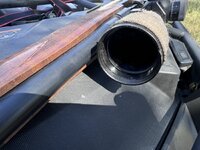
Next day zero check-
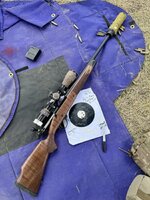
Vortex Diamond Back HD 3-12x lost zero in less than 40 rounds, and continued to lose zero constantly. It was pulled after one day.
Not a scope, but a base/ring issue: a shooter using Tally Lightweight ring/base mounted correctly as per Tally’s instructions- was shooting 7-8 inch groups vertically. Inspection found that the scope was spilling (pencil mark). The user decided to replace the rings with UM ones instead of chasing and fighting the Tally’s. No farther issues after the replacement.
Of note, we had two very competent shooters using 223’s with mil/mil FFP scopes who had first round hit rates between 80-90% on day one during the classes, that switched and used MOA and BDC scopes for a lot of the training. The NF SHV and Trijicon Credo with MOA turrets and duplex reticles worked fine, however time to first round was much slower due to the requirement to look at a drop chart for the required elevation correction. As well, beyond 300 yards- while usable, hit rates were lower due to no windage correction holds on the reticle.
The BDC reticle had by far the lowest vital zone hit rate past 200 yards, dropping first round hits to 50’ish percent (or less) out to 400 yards, and 10-20% (or less) out to 500 yards. This was due having no clear way to hold for wind while holding over and between hash marks. Also, a couple of shots were widely off due to the power not being set correctly for the SFP reticle.
MOA is a compromise for quickly getting hits in field shooting- the first shooters response after using it for the first week (and beating almost all other shooters) was- MOA is dumb. The seconds thoughts were worse. BDC reticles continue to show to be poor performers for 1st round hits in novel field conditions, versus on a flat range and with sand bags. The second shooters statement who used the BDC reticle scope violates the forum rules.
Conclusion:
This class overall was a bit more mechanically competent or inclined and moved at a quicker than usual pace- they were one day ahead of most classes by day three.
Though they had less wind to deal with, by the end of the week, first round hit rates in the vitals of game animals from 100-800’ish yards were above 80% on average, and for some were nearly 90%.
